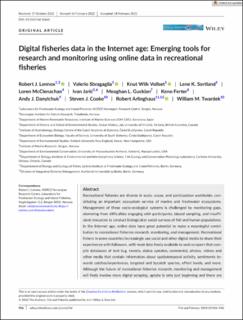| dc.description.abstract | Recreational fisheries are diverse in scale, scope, and participation worldwide, constituting an important ecosystem service of marine and freshwater ecosystems. Management of these socio-ecological systems is challenged by monitoring gaps, stemming from difficulties engaging with participants, biased sampling, and insufficient resources to conduct biological or social surveys of fish and human populations. In the Internet age, online data have great potential to make a meaningful contribution to recreational fisheries research, monitoring, and management. Recreational fishers in some countries increasingly use social and other digital media to share their experiences with followers, with most data freely available to web scrapers that compile databases of text (e.g. tweets, status updates, comments), photos, videos and other media that contain information about spatiotemporal activity, sentiments towards catches/experiences, targeted and bycatch species, effort levels, and more. Although the future of recreational fisheries research, monitoring and management will likely involve more digital scraping, uptake is only just beginning and there are several challenges including tool availability/accessibility, sampling biases, and making findings relevant and usable to practitioners. Despite these challenges, we envision fisheries managers will increasingly turn towards online sources of fisheries data to supplement conventional methods. We challenge scientists to work towards continued method development and validation of various digital fisheries data tools and emphasize how biases from the online behaviour of users may complicate interpretations of these data for fisheries management. | en_US |

